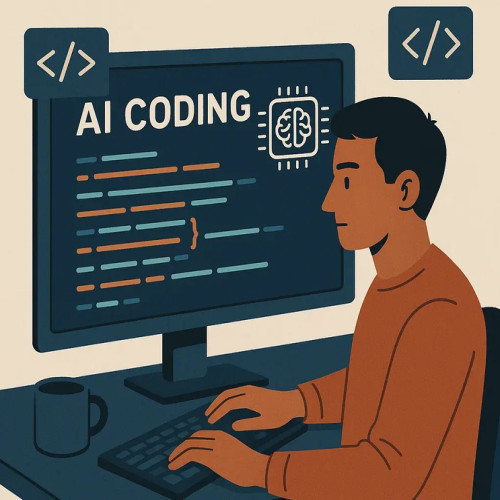
The year is 2025, and if you’re still typing every line of code manually in your IDE, you’re lagging behind. The age of AI coding is not just the future; it’s the now. AI-assisted tools have become indispensable companions in software development, whether you’re running your first “Hello World” or leading a development team on a full-scale enterprise project.
AI coding tools don’t just help you code faster, they help you code smarter. From generating entire functions with one prompt to debugging in real time, AI development assistants have redefined how modern developers work. In this article, we’ll explore the top five AI coding tools you shouldn’t miss if you want to stay ahead in 2025.
Table of Contents
1. GitHub Copilot – The Industry Standard

GitHub Copilot remains the undisputed leader among AI coding assistants. Developed jointly by GitHub and OpenAI, it has evolved into one of the most context-aware, powerful, and responsive code companions on the market.
Copilot’s strength lies in its deep integration with popular IDEs like VS Code, JetBrains, and Neovim, as well as its ability to interpret natural language comments and translate them into functional code. It supports a wide range of programming languages, Python, JavaScript, Go, C++, and more, and can generate functions, entire classes, or even test cases with remarkable accuracy.
Beyond completion, Copilot can also explain code, refactor, and optimize functions on the fly, helping developers write clean and efficient code. GitHub Copilot offers a free plan for students and open-source contributors, while professionals can opt for premium plans for team-wide collaboration and advanced AI integrations.
Verdict: The benchmark of AI coding assistance, fast, precise, and deeply integrated into developer workflows.
2. Cursor AI – The Smart AI Code Editor

Unlike other assistants that integrate into IDEs, Cursor AI is an AI-native code editor. Built for AI collaboration from the ground up, it doesn’t just auto-complete code, it understands the broader logic of your project. It just takes AI coding to next level.
Cursor AI can analyze entire file structures, track context across your repository, and modify or generate code aligned with your intent. It also offers features such as AI-powered debugging, in-editor explanations, and contextual chat support.
However, being relatively new, Cursor’s ecosystem is still growing, and some advanced features remain behind premium subscriptions. Yet, for developers seeking a futuristic and intelligent environment that truly “codes with you,” Cursor stands tall.
Verdict: A next-generation AI coding editor redefining how we collaborate with code, limited ecosystem but unmatched contextual intelligence.
3. Windsurf (formerly Codeium) – The Free Powerhouse

Rebranded from Codeium, Windsurf has become one of 2025’s fastest-rising AI coding tools for developers. Supporting over 70 programming languages, it delivers lightning-fast code completion, real-time suggestions, and cross-IDE compatibility, all at zero cost.
Windsurf’s “plug-and-play” nature makes it perfect for students, freelancers, and individual developers who want robust AI coding assistance without the price tag. It integrates seamlessly with VS Code, JetBrains, and Jupyter, making it one of the most accessible tools in the market.
While Windsurf doesn’t offer deep customization or private model training like Tabnine, its speed, simplicity, and no-setup requirement make it a solid contender for anyone starting out or coding on the go.
Verdict: Free, fast, and flexible, ideal for developers who value performance without cost.
4. Tabnine – The Private, Secure AI Partner

Tabnine has long stood out for its commitment to privacy and data security. Unlike many competitors that rely on OpenAI’s public models, Tabnine operates on independently trained AI models. This means organizations can self-host the system, ensuring their code remains confidential, a major advantage for enterprises handling sensitive data.
The tool learns and adapts to each developer’s personal coding style, providing more personalized and contextually relevant suggestions over time. It integrates smoothly with top IDEs like VS Code, IntelliJ, and Sublime Text.
However, Tabnine doesn’t include conversational chatbot features, and it’s performance can feel slower compared to competitors. The subscription-only structure may also make it less appealing for solo developers or students.
Verdict: Exceptional for teams prioritizing data privacy and internal model training, less ideal for those seeking speed or conversational features.
5. Replit Ghostwriter – The Cloud-Based Coding Companion

Rounding out the list, Replit Ghostwriter is perfect for beginners and those who prefer web-based environments. Developed by Replit Inc., Ghostwriter is integrated directly into the Replit IDE, a browser-based coding platform that eliminates the need for local setups.
Ghostwriter assists in real-time code completion, automatic bug fixing, and multi-language support while running entirely in the cloud. This makes it lightweight, accessible, and ideal for learners or developers working on quick prototypes.
Replit offers a limited free version, with student and teacher discounts available for premium plans. The only downside? Its AI depth and accuracy lag slightly behind the other top tools, especially in larger-scale projects.
Verdict: A fantastic starting point for students and hobbyists, simple, cloud-based, and effective for smaller-scale development.
Honorable Mentions
While the top five dominated the field, several other AI tools have made noteworthy contributions to modern development:
Conclusion
AI is no longer an accessory in coding, it’s the backbone of modern development. From Copilot’s deep contextual understanding to Cursor’s intelligent environment and Windsurf’s accessibility, the AI coding tools of 2025 are transforming the way we think, write, and debug code.
Whether you’re a student exploring your first project or a developer building enterprise-scale systems, embracing these AI tools isn’t just about keeping up, it’s about leading the next wave of innovation.
So before you fall behind, pick your AI partner, start experimenting, and remember, the smartest coders aren’t the ones who type more, but the ones who build smarter.
For more content, updates and news in Tech World, be with us in LoginAid.com
- Best 5 ChatGPT Alternatives: Top AI Agents You Need - December 8, 2025
- Best 5 WhatsApp Alternatives: Top Messaging Apps To Replace WhatsApp - December 1, 2025
- Best 3 Video Players for iPhone: Top Picks For Perfect Playback - November 26, 2025